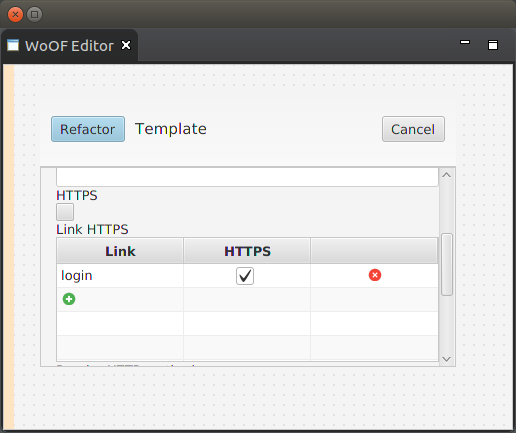Secure Link Tutorial
This tutorial looks at configuring a specific link for a page to only be accessed via a secure channel (HTTPS).
The below example for this tutorial will implement a simple non-secure page to provide login credentials via a secure link. The simple page for this tutorial is as follows:

HTML
The page template content is as follows. Please note the link in the form action.
<html>
<body>
<form action="#{login}" method="POST">
Username: <input type="text" name="username" /> <br />
Password: <input type="password" name="password" />
</form>
Other content of non-secure page.
</body>
</html>
Secure Link
To configure the link (form action) to always be communicated via a secure channel, the following is the configuration:

Adding the link and flagging it secure will ensure WoOF renders the link URL on the page to communicate over a secure channel (HTTPS). WoOF also prevents non-secure access to the link servicing by responding with a redirect to use a secure channel.
The configuration of links also works in reverse. Should the template be configured as secure, adding the link and leaving it unchecked indicates a non-secure link. Note that unless configured, links will follow the template secure setting.
Logic
The logic for the page is the following:
public class TemplateLogic {
@Data
@HttpParameters
public static class LoginParameters implements Serializable {
private static final long serialVersionUID = 1L;
private String username;
private String password;
}
public void login(LoginParameters credentials, ServerHttpConnection connection) {
// Confirm a secure connection (not needed but included for tutorial)
if (!connection.isSecure()) {
throw new IllegalStateException();
}
// Logic for login
}
}
This tutorial shows sending information over a secure channel (HTTPS) from a non-secure page.
Unit Test
The unit test demonstrates the rendering of the secure link.
@ExtendWith(OfficeFloorExtension.class)
public class SecureLinkHttpServerTest {
@RegisterExtension
public final HttpClientExtension client = new HttpClientExtension();
@Test
public void ensureLinkRenderedSecure() throws Exception {
// Obtain the page
HttpResponse response = this.client.execute(new HttpGet("http://localhost:7878"));
String renderedPage = EntityUtils.toString(response.getEntity());
// Ensure login form (link) is secure
assertTrue(renderedPage.contains("form action=\"https://localhost:7979/+login"), "Login form should be secure");
}
}
Next
The next tutorial looks at authentication.


